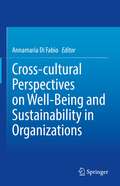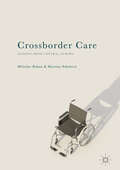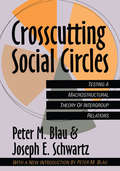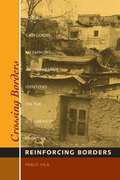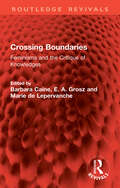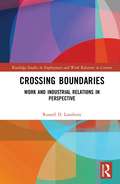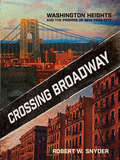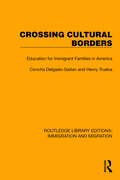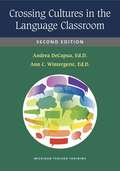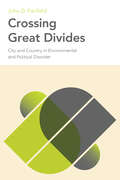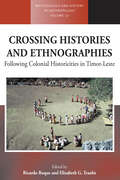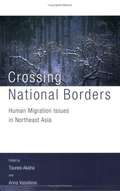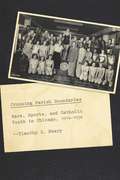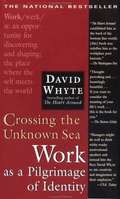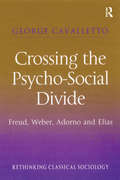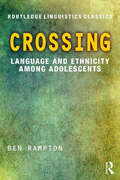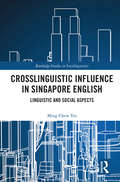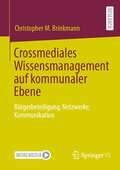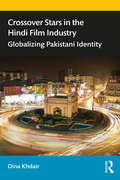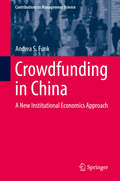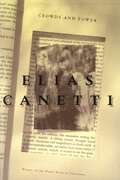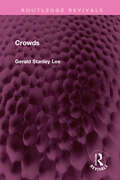- Table View
- List View
Cross-cultural Perspectives on Well-Being and Sustainability in Organizations
by Annamaria Di FabioThis book explores a new area of psychology of sustainability and sustainable development with specific focus on organizations, and introduces a range of advanced perspectives for healthy business, harmonization and decent work. Split into two parts, the first half presents cross-cultural contributions that study in depth the benefits and drawbacks of sustainability, while the second half discusses theoretical approaches and empirical research that offer new prospects for innovation in prevention science. Gathering research from leading scholars and researchers from around the globe, this book offers an essential reference guide that will benefit researchers, professionals, students, and policy makers interested in promoting better business harmony and sustainability.
Crossborder Care: Lessons from Central Europe
by Miloslav Bahna Martina SekulováThis book analyses the circular migration of care workers in Central Europe using the example of Slovak carers in 24-hour care provision for the elderly in Austria. Challenging analyses that focus primarily on care drain and care regimes, Bahna and Sekulová supplement quantitative methodology with qualitative fieldwork to demonstrate the importance of the sending country’s economic context. The authors discuss the dynamics of economic differences between Austria and its post-communist neighbors as preconditions of the crossborder care provision, bridging analyses of policy and legal frameworks with approaches from labor migration study. Even as they scrutinize the relevance of care drain-based analyses, Bahna and Sekulová bring to the fore the interplay of economic differences, social policies, gender and migration regimes with geographic proximity to study long-term impacts of care work, including an analysis of employment after care work.
Crosscutting Social Circles: Testing a Macrostructural Theory of Intergroup Relations
by Peter M. Blau Joseph E. SchwartzCrosscutting Social Circles describes a theory of groups' relations to each other, and tests the theory in the 125 largest metropolitan areas In the United States. The focus is on the Influence social structure exerts on intergroup relations. Blau and Schwartz show how role relations are influenced by how people are distributed among social positions. Examples are a community's racial composition, division of labor, ethnic heterogeneity, income Inequality, or the extent to which educational differences are related to income differences. Blau and Schwartz test their theory by considering its impact on such structural conditions as intermarriage, an important form of intergroup relations.The authors derive the main principles of previously formulated theories of intergroup relations and present them in simpler and clearer form. They empirically test the power of the theory by analyzing its ability to predict how social structure affects intermarriage in the largest American cities, where three-fifths of the American population live. They selected cities because population distribution of a small neighborhood might be affected by casual associations among neighbors; it is much more sociologically interesting if population distribution also affects mate selection in a city of millions.Unlike most theories that emphasize the implications of such cultural orientations as shared values and common norms, this volume focuses on the significance of various forms of inequality and heterogeneity. As one of the few books that supplies a large-scale empirical test of implications of a theory, Crosscutting Social Circles serves as a model. The new introduction by Peter Blau reviews the origins and impact of the book. It will be of immense value to sociologists, psychologists, and group relations specialists.
Crossing Borders, Reinforcing Borders: Social Categories, Metaphors, and Narrative Identities on the U.S.-Mexico Frontier
by Pablo VilaThis pathfinding ethnography charts the social categories, metaphors, and narratives that inhabitants of El Paso and Ciudad Juárez use to define their group identity and distinguish themselves from "others." Pablo Vila draws on over 200 group interviews with more than 900 area residents to describe how Mexican nationals, Mexican immigrants, Mexican Americans, African Americans, and Anglos make sense of themselves and perceive their differences from others.
Crossing Boundaries: Feminisms and the Critique of Knowledges (Routledge Revivals)
by Barbara Caine Marie De Lepervanche E. A. GroszFirst published in 1988, Crossing Boundaries challenges existing disciplines and fields of study from a feminist perspective, contesting their presumptions, and questioning and crossing their boundaries.The book provides a broad-ranging overview of the state of feminist interventions in the social and natural sciences and the humanities. It illustrates something of the diversity of approaches to theory and scholarship which is evident in the work of feminists. It analyses crucial problems in the way traditional knowledges are conceived, and poses exciting new alternatives.Here is a lively display of the vigour of feminist investigations, from mathematics to literary criticism, from biology to socialism, from equal pay to polyandry. This book will introduce the reader to the work of feminist thinkers and will be a valuable text for students and teachers of sociology and women’s studies.
Crossing Boundaries: Work and Industrial Relations in Perspective (Routledge Studies in Employment and Work Relations in Context)
by Russell D. LansburyThis book provides thoughtful insights into the development in work, organisations and employment relations in the last 50 years. In a semi-autobiographical approach, the author reflects on important contributions by other scholars, practitioners, and policy makers to work and employment relations. The book covers a variety of themes which have been the subject of research undertaken by the author over his career and explores these themes over a period of time with examples drawn from various countries. It also emphasises that countries and regions cannot be understood in isolation from each other. The author seeks to convey the importance of crossing disciplinary boundaries in the social sciences in order to interpret changes in work, organisations and employment relations. Drawing on the author’s rich experience and research, the book is engaging and accessible to anyone who wishes to learn more about the rapidly changing workplace and employment relations.
Crossing Broadway: Washington Heights and the Promise of New York City
by Robert W. SnyderRobert W. Snyder's Crossing Broadway tells how disparate groups overcame their mutual suspicions to rehabilitate housing, build new schools, restore parks, and work with the police to bring safety to streets racked by crime and fear. It shows how a neighborhood once nicknamed "Frankfurt on the Hudson" for its large population of German Jews became "Quisqueya Heights"—the home of the nation's largest Dominican community.The story of Washington Heights illuminates New York City's long passage from the Great Depression and World War II through the urban crisis to the globalization and economic inequality of the twenty-first century. Washington Heights residents played crucial roles in saving their neighborhood, but its future as a home for working-class and middle-class people is by no means assured. The growing gap between rich and poor in contemporary New York puts new pressure on the Heights as more affluent newcomers move into buildings that once sustained generations of wage earners and the owners of small businesses.Crossing Broadway is based on historical research, reporting, and oral histories. Its narrative is powered by the stories of real people whose lives illuminate what was won and lost in northern Manhattan's journey from the past to the present. A tribute to a great American neighborhood, this book shows how residents learned to cross Broadway—over the decades a boundary that has separated black and white, Jews and Irish, Dominican-born and American-born—and make common cause in pursuit of one of the most precious rights: the right to make a home and build a better life in New York City.
Crossing Cultural Borders: Education for Immigrant Families in America (Routledge Library Editions: Immigration and Migration #6)
by Concha Delgado-Gaitan Henry TruebaCrossing Cultural Borders (1991) examines the day-to-day interaction of immigrant children with adults, siblings and peers in the home, school and community at large as these families demonstrate their skill in using their culture to survive in a new society. Children of Mexican and Central American immigrant families in Secoya crossed a national border, and continue to cross linguistic, social and cultural borders that separate the home, school and outside world.
Crossing Cultures In The Language Classroom, Second Edition
by Andrea DeCapua Ann WintergerstCrossing Cultures in the Language Classroom attempts to balance theory and practice for pre-service and in-service teachers in general education programs or in ESL/EFL, bilingual, and foreign language teacher training programs, as well as cross-cultural awareness workshops. This book is unique in that it combines theory with a wide range of experiential activities and projects designed to actively engage users in the process of understanding different aspects of cross-cultural awareness. The goals of the book are to help readers: expand cultural awareness of one’s own culture and that of others achieve a deeper understanding of what culture is and the relationship between culture and language acquire the ability to observe behaviors in order to draw conclusions based on observation rather than preconceptions understand and implement observations of cultural similarities and differences develop an attitude of tolerance toward cultural differences and move away from the “single story.” The new edition has been thoroughly updated and includes a Suggested Projects section in each chapter. This section provides opportunities for users of the text to explore in greater depth an area and topic of interest. It also includes even more Critical Incidents--brief descriptions of events that depict some element or elements of cultural differences, miscommunication, or culture clash. Critical Incidents develop users’ ability to analyze and understand how multiple perspectives of the same situation are rooted in differing culturally influenced beliefs, behaviors, norms of interaction, and worldviews.
Crossing Great Divides: City and Country in Environmental and Political Disorder (Urban Life, Landscape and Policy)
by John D. FairfieldRanging across two centuries of American history, Crossing Great Divides argues that the habit of construing city and country as opposites is at the root of our current environmental and political disorder. This oversimplifying dualism has distorted how we planned cities, our patterns of production and consumption, how we deal with waste, and how urban and rural populations perceive each other. Conventional urban environmental reform has made modern city life possible, but it has done little to limit the despoliation of distant places. Nevertheless, the successes of urban environmental reform remind us of what is possible. John Fairfield concludes with a case study of Phoenix, Arizona to demonstrate this dysfunctional relationship between city and country while developing a sympathetic critique of the Green New Deal. He suggests how we might bridge the “great divide” as we face the daunting challenges the twenty-first century is pressing upon us.
Crossing Histories and Ethnographies: Following Colonial Historicities in Timor-Leste (Methodology & History in Anthropology #37)
by Ricardo Roque Elizabeth G. TraubeThe key question for many anthropologists and historians today is not whether to cross the boundary between their disciplines, but whether the idea of a disciplinary boundary should be sustained. Reinterpreting the dynamic interplay between archive and field, these essays propose a method for mutually productive crossings between historical and ethnographic research. It engages critically with the colonial pasts of indigenous societies and examines how fieldwork and archival studies together lead to fruitful insights into the making of different colonial historicities. Timor-Leste’s unusually long and in some ways unique colonial history is explored as a compelling case for these crossings.
Crossing Histories and Ethnographies: Following Colonial Historicities in Timor-Leste (Methodology & History in Anthropology #37)
by Ricardo Roque and Elizabeth G. TraubeThe key question for many anthropologists and historians today is not whether to cross the boundary between their disciplines, but whether the idea of a disciplinary boundary should be sustained. Reinterpreting the dynamic interplay between archive and field, these essays propose a method for mutually productive crossings between historical and ethnographic research. It engages critically with the colonial pasts of indigenous societies and examines how fieldwork and archival studies together lead to fruitful insights into the making of different colonial historicities. Timor-Leste’s unusually long and in some ways unique colonial history is explored as a compelling case for these crossings.
Crossing National Borders: Human Migration Issues in Northeast Asia
by Tsuneo Akaha Anna VassilievaAlthough they vary in methodological and topical entrance, the ten papers presented in this text are unified, suggest the editors (of the Monterey Institute of International Studies), in their concern with such basic questions of cross-border migration in Northeast Asia as the contribution of migration to regional identity, the possibilities of multilateral cooperation in responding to migration, and the impact of migration on the security concerns of governments and peoples of the region. Specific topics include perceptions of costs and benefits among Chinese migrants and their host governments; the interaction of Russian and Chinese residents with provincial communities in Japan; issues of cultural identity, social assimilation, and generational change among Korean communities in Japan; human security concerns of Koreans in China; immigration and emigration issues in South Korea; and the evolution of immigration policy in Mongolia.
Crossing Parish Boundaries: Race, Sports, and Catholic Youth in Chicago, 1914-1954 (Historical Studies of Urban America)
by Timothy B. NearyControversy erupted in spring 2001 when Chicago's mostly white Southside Catholic Conference youth sports league rejected the application of the predominantly black St. Sabina grade school. Fifty years after Brown v. Board of Education, interracialism seemed stubbornly unattainable, and the national spotlight once again turned to the history of racial conflict in Catholic parishes. It's widely understood that midcentury, working class, white ethnic Catholics were among the most virulent racists, but, as Crossing Parish Boundaries shows, that's not the whole story. In this book, Timothy B. Neary reveals the history of Bishop Bernard Sheil's Catholic Youth Organization (CYO), which brought together thousands of young people of all races and religions from Chicago's racially segregated neighborhoods to take part in sports and educational programming. Tens of thousands of boys and girls participated in basketball, track and field, and the most popular sport of all, boxing, which regularly filled Chicago Stadium with roaring crowds. The history of Bishop Sheil and the CYO shows a cosmopolitan version of American Catholicism, one that is usually overshadowed by accounts of white ethnic Catholics aggressively resisting the racial integration of their working-class neighborhoods. By telling the story of Catholic-sponsored interracial cooperation within Chicago, Crossing Parish Boundaries complicates our understanding of northern urban race relations in the mid-twentieth century.
Crossing The Unknown Sea: Work As A Pilgrimage Of Identity
by David WhyteCrossing the Unknown Sea is about reuniting the imagination with our day to day lives. It shows how poetry and practicality, far from being mutually exclusive, reinforce each other to give every aspect of our lives meaning and direction. For anyone who wants to deepen their connection to their life's work—or find out what their life's work is—this book can help navigate the way. Whyte encourages readers to take risks at work that will enhance their personal growth, and shows how burnout can actually be beneficial and used to renew professional interest. He asserts that too many people blindly trudge through a mediocre work life because so many “busy” tasks prevent significant reflection and analysis of job satisfaction. People often turn to spiritual practice or religion to nurture their souls, but overlook how work can actually be our greatest opportunity for discovery and growth. Crossing the Unknown Sea combines poetry, gifted storytelling and Whyte's personal experience to reveal work's potential to fulfill us and bring us closer to ultimate freedom and happiness.
Crossing the Psycho-Social Divide: Freud, Weber, Adorno and Elias (Rethinking Classical Sociology Ser.)
by George CavallettoThe prevailing view among social scientists is that the psyche and the social reside in such disparate domains that their proper study demands markedly incompatible analytical and theoretical approaches. Over the last decade, scholars have begun to challenge this view. In this innovative work, George Cavalletto moves this challenge forward by connecting it to theoretical and analytical practices of the early 20th century. His analysis of key texts by Sigmund Freud, Max Weber, Theodor Adorno and Norbert Elias shows that they crossed the psycho-social divide in ways that can help contemporary scholars to re-establish an analytical and theoretical understanding of the inherent interconnection of these two domains. This book will particularly interest scholars and students in sociology and social psychology, especially those in the fields of social theory, the sociology of emotion, self and society, and historical sociology.
Crossing: Language and Ethnicity among Adolescents (Routledge Linguistics Classics)
by Ben RamptonFocusing on urban youth culture and language crossing, this foundational volume by Ben Rampton has played a pivotal role in the shaping of language and ethnic identity as a domain of study. It focuses on language crossing - the use of Panjabi by adolescents of African-Caribbean and Anglo descent, the use of Creole by adolescents with Panjabi and Anglo backgrounds, and the use of stylized Indian English. Crossing’s central question is: how far and in what ways do these intricate processes of language sharing and exchange help to overcome race stratification and contribute to a new sense of mixed youth, class and neighbourhood community? Ben Rampton produces detailed ethnographic and interactional analyses of spontaneous speech data, and integrates the discussion of particular incidents with theories of discourse, code-switching, social movements, resistance and ritual drawn from sociolinguistics, sociology, anthropology and cultural studies. Now a Routledge Linguistics Classic with a new preface which sets the work in its current context, this book remains key reading for all those working in the areas of applied linguistics, sociolinguistics and linguistic anthropology.
Crosslinguistic Influence in Singapore English: Linguistic and Social Aspects (Routledge Studies in Sociolinguistics)
by Ming Chew TeoIn a social setting where speakers with several languages interact extensively, a major source of variation in Colloquial Singapore English comes from the complex interaction between crosslinguistic influences and various social and linguistic factors. By unifying both social and linguistic aspects of the phenomenon through the use of multivariate analyses like logistic regressions and Poisson regressions, this book represents a novel approach to the study of crosslinguistic influence in Colloquial Singapore English. As multivariate analyses provide us with information regarding the relative strengths of each social and linguistic factor, they are useful tools that allow us to have a more nuanced understanding of crosslinguistic influence in contact situations. Linguistic features from a variety of linguistic domains – morphology, semantics, and discourse – will be quantified, and statistical analyses will be run in R to determine the degree to which various social and linguistic factors affect the extent of crosslinguistic influence. Well-known Singlish features like the optionality of past tense and plural marking, the unique meanings of already, got, and one, and discourse particles lah, leh, and lor, are analyzed using this approach. The statistical modeling of these features is a first step towards creating a unified framework to understanding crosslinguistic influence.
Crossmediales Wissensmanagement auf kommunaler Ebene: Bürgerbeteiligung, Netzwerke, Kommunikation
by Christopher M. BrinkmannIn diesem Buch werden die Bürgerbeteiligung auf kommunaler Ebene und das Wissen, das über Kommunikation in den Netzwerken der Akteure der politischen Partizipation und des zivilgesellschaftlichen Engagements tradiert wird, aus medien- und kommunikationswissenschaftlicher Sicht betrachtet. Der Fokus der Untersuchung liegt auf dialogorientiert-informellen Verfahren und dem medienübergreifenden Abrufen, Akkumulieren, Generieren und Ausbilden von Wissen in der Bürgerbeteiligung über ein crossmediales Wissensmanagement. Aus der Zusammenführung normativ-theoretischer Überlegungen und der empirischen Befunde einer Feldforschung im Raum Mittweida wird das Konzept der wissensorientierten Bürgerkommune entwickelt. Dafür werden fünf Bausteine vorgeschlagen, die bei der Etablierung von dialogorientiert-informeller Bürgerbeteiligung sowie einem crossmedialen Wissensmanagement auf kommunaler Ebene helfen können. Die normativ-theoretischen Überlegungen, die empirischen Befunde und auch die Konzeptentwicklung sind sowohl für den wissenschaftlichen Diskurs um die Förderung von Bürgerbeteiligung als auch für Praktiker der Zivilgesellschaft und der politisch-administrativen Ebene in Kommunen relevant.
Crossover Stars in the Hindi Film Industry: Globalizing Pakistani Identity
by Dina KhdairThis book explores the cultural politics of Pakistani crossover stardom in the Hindi film industry as a process of both assimilation and “Otherness”. Analysing the career profiles of three crossover performers – Ali Zafar, Fawad Khan, and Mahira Khan – as a relevant case study, it unites critical globalization studies with soft power theory in exploring the potential of popular culture in conflict resolution. The book studies the representation and reception of these celebrities, while discussing themes such as the meaning of being a Pakistani star in India, and the consequent identity politics that come into play. As the first comprehensive study of Pakistani crossover stardom, it captures intersections between political economy, cultural representation, and nationalist discourse, at the same time reflecting on larger questions of identity and belonging in an age of globalization. Crossover Stars in the Hindi Film Industry will be indispensable to researchers of film studies, media and cultural studies, popular culture and performance, peace and area studies, and South Asian studies. It will also be of interest to enthusiasts of Indian cinematic history.
Crowdfunding in China: A New Institutional Economics Approach (Contributions to Management Science)
by Andrea S. FunkChina is currently the front-runner on the global crowdfunding market, even though this form of financing originated in the USA. Crowdfunding in China, however, differs significantly from its counterpart in the West. This book reveals that Chinese crowdfunding is a product of the country’s dynamic internet sector, which is based on mobile internet, e-commerce, and online/mobile payments, together with significant government support. The author presents a comprehensive theoretical, empirical and field-based work on crowdfunding in China. Adopting a new institutional economics approach, it maps and deciphers the origins and paths of informal finance that have led to internet finance and the rise of crowdfunding platforms. In addition, three case studies are analyzed and their implications for crowdfunding stakeholders in China are discussed.
Crowds And Power
by Elias Canetti Carol StewartCrowds and Power is a revolutionary work in which Elias Canetti finds a new way of looking at human history and psychology. Breathtaking in its range and erudition, it explores Shiite festivals and the English Civil war, the finger exercises of monkeys and the effects of inflation in Weimar Germany. In this study of the interplay of crowds, Canetti offers one of the most profound and startling portraits of the human condition.
Crowds: A Moving-picture Democracy (Routledge Revivals)
by Gerald Stanley LeeThis book, first published in 1913, examines early twentieth century thinking on crowds and human nature. The imagination of crowds and the desire to be good, to be happy and successful, together with the wish for the new are all considered along with the changes in the politics and industry of the time.
Crowds: Ethnographic Encounters (Encounters: Experience and Anthropological Knowledge)
by Megan SteffenWhat exactly is a crowd? How do crowds differ from other large gatherings of people? And how do they transform emotions, politics, or faith? In Crowds, contributors draw on their experiences and expertise to reflect on their encounters with crowds. Each chapter examines a particular crowd or conception of crowdedness to provide an analysis of how, when, where—and with whom—crowds form in different contexts, as well as their purpose and the practical effect the experience has on both the participants and their environment. The wide selection of case studies ranges from the crowds that form every year during the Hajj, to New Year celebrations in China, commuters on the Delhi metro, public prayer in Nigeria, online mobs in Bangladesh, and the crowds that have emerged during protest movements in Thailand and Syria. Crowds makes a key contribution to establishing an anthropological theory of crowds and will be an essential read for both students and researchers.
Crowds: Ethnographic Encounters (Encounters: Experience and Anthropological Knowledge)
by Megan SteffenWhat exactly is a crowd? How do crowds differ from other large gatherings of people? And how do they transform emotions, politics, or faith? In Crowds, contributors draw on their experiences and expertise to reflect on their encounters with crowds. Each chapter examines a particular crowd or conception of crowdedness to provide an analysis of how, when, where—and with whom—crowds form in different contexts, as well as their purpose and the practical effect the experience has on both the participants and their environment. The wide selection of case studies ranges from the crowds that form every year during the Hajj, to New Year celebrations in China, commuters on the Delhi metro, public prayer in Nigeria, online mobs in Bangladesh, and the crowds that have emerged during protest movements in Thailand and Syria. Crowds makes a key contribution to establishing an anthropological theory of crowds and will be an essential read for both students and researchers.
